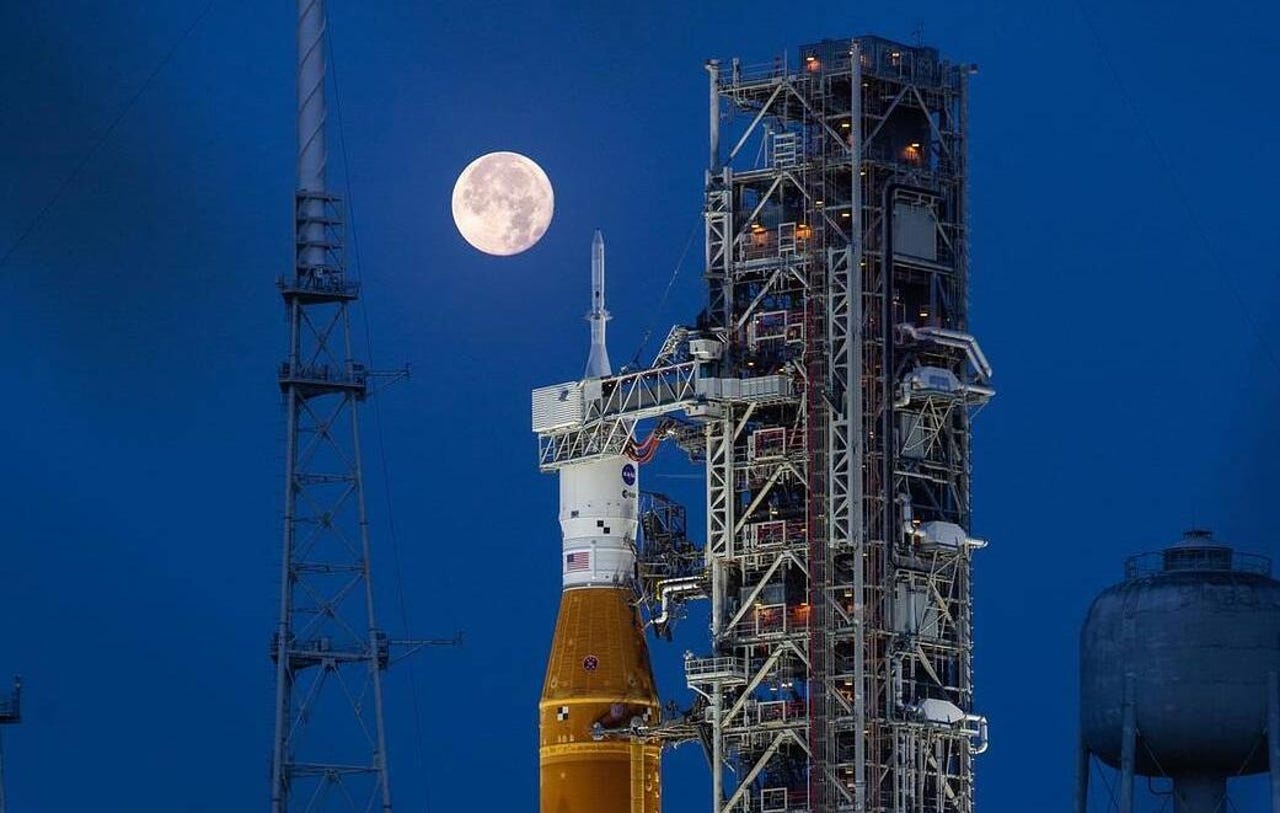































 Image: NASA/Cory Huston
Image: NASA/Cory Huston NASA early on Saturday stood down its second attempt to launch the Artemis 1 mission into lunar orbit after engineers failed to seal a hydrogen leak that occurred while loading propellants into the rocket's core stage fuel tanks. After the second launch attempt failed, NASA likely won't shoot for a third attempt in September.
NASA said the hydrogen leak occurred in an an "interface between the liquid hydrogen fuel feed line and the Space Launch System (SLS) rocket". The SLS is uniquely capable of carrying the Orion spacecraft, astronauts and supplies to the Moon on a single mission.
The Artemis 1 mission's second launch, an unmanned test, was set for Saturday 2:17 pm ET (11:17 am PT) at the Kennedy Space Center in Florida.
The SLS core stage, manufactured by Boeing, measures 212 feet (64.6 meters) high with a diameter of 27.6 feet (8.4 meters). It stores cryogenic liquid hydrogen and liquid oxygen as well as the systems to feed the stage's four R2-25 engines.
SEE:What is Artemis? Everything you need to know about NASA's new moon mission
Artemis is a multi-stage project that plans to send astronauts back to the Moon -and beyond. The Artemis mission will also see the first woman and person of color landing on the Moon.
NASA's Artemis mission team had previously called off an August 29 launch attempt when engineers couldn't cool all four RS-25 engines to minus 420 degrees Fahrenheit (-250C) -a necessary step to ensure the core stage isn't damaged on the eight-minute journey to low-Earth orbit. After reaching low-Earth orbit, the core stage separates from the upper stage and Orion spacecraft.
During the second launch attempt, one of the four engines was showing higher temperatures than the others, according to NASA. This so-called "bleed test" happens prior to super cold liquid hydrogen flowing into the rocket's core stage.
During the first attempted launch, engineers also discovered a hydrogen leak on a "purge can" but at that stage it could be managed by manually adjusting propellant flow rates.
Following Saturday's failed bid to launch the Artemis 1 mission, NASA revealed it tried three times to plug the leak.
"Engineers saw a leak in a cavity between the ground side and rocket side plates surrounding an 8-inch line used to fill and drain liquid hydrogen from the SLS rocket. Three attempts at reseating the seal were unsuccessful," NASA said in an update on Saturday evening.
NASA is investigating whether an "inadvertent command" sent during an early phase of loading hydrogen temporarily raised the pressure in the system and may have contributed to the leaky seal.
"While in an early phase of hydrogen loading operations called chilldown, when launch controllers cool down the lines and propulsion system prior to flowing super cold liquid hydrogen into the rocket's tank at minus 423 degrees F, an inadvertent command was sent that temporarily raised the pressure in the system. While the rocket remained safe and it is too early to tell whether the bump in pressurization contributed to the cause of the leaky seal, engineers are examining the issue," said NASA.
SEE:NASA's new tiny, high-powered laser could find water on the Moon
At approximately 11:17 am ET, about three hours before Saturday's launch window was set to open, Artemis launch director Charlie Blackwell-Thompson opted to scrub the second attempt.
Per Reuters, NASA had reserved backup launch times for either Monday or Tuesday this week, but concluded it would take longer than that to repair the new hydrogen leak. The next available period is between September 19 and 30 or another window in October, associate NASA administrator, Jim Free, said at a media briefing.
Mike Sarafin, NASA's Artemis mission manager, said it would take "several weeks of work" to resolve the current technical issues. If this involves rolling the SLS back to the assembly building, any launch could then be pushed back until the middle of October.
According to NASA's Artemis mission availability web page, between October 17 and October 31 there are 11 launch opportunities. The rocket can't just launch on any day -there are four key criteria to be met.
 Горячие метки:
3. Инновации
1. Космос
Горячие метки:
3. Инновации
1. Космос